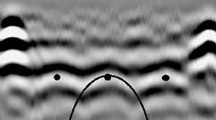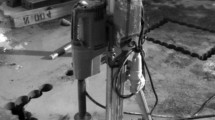Abstract
In moderate and destructive environments, the issue of corrosion in the reinforcement of reinforced concrete structures has become a serious problem. In this paper, GPR based on digital image processing was used to monitor and estimate the degree of corrosion based on GPR technology in an intelligent, simple, and cost-effective way. The ground penetrating radar antenna at 1 GHz frequency was employed to evaluate concrete walls, roofs, and floors to demonstrate the corrosion of reinforced steel structures. Five programs were used for the analysis and interpretation as follows: RadExplorer, Easy3D, 3D Vision, Fourier Editor, ERDAS Imagine, and ArcGIS pro 2.8. The radargram images were transformed to frequency domain (Fourier) and enhanced by using a Gaussian low pass filter to remove noise, anomalies, and unwanted information. To enhance the versions of radargram's images, Inverse Fourier Transform was utilized to retransform them. To check the validity, two types of rebars were installed in the specimens. Uncorroded rebar with a 12 mm diameter was installed in the first specimen and corroded rebar of 12 mm with a 15% level of corrosion was installed in the second specimen. When scanning by GPR, the results were promising. Significant results, highest Estimated Level of Corrosion in Rebar that emerged from the analysis of GPR data were 20% in the roof, 15% in the concrete floor, and 11% in the concrete wall, respectively. Both simulation data and actual GPR field test data were used in the experiments. The Results validated the algorithm's efficiency in detecting and identifying corrosion in RC structures.











Similar content being viewed by others
References
Agred K, Klysz G, Balayssac J-P (2018) Location of reinforcement and moisture assessment in reinforced concrete with a double receiver GPR antenna. Constr Build Mater 188(2018):1119–1127
Rodrigues R, Gaboreau S, Gance J, Ignatiadis I, Betelu S (2020) Reinforced concrete structures: a review of corrosion mechanisms and advances in electrical methods for corrosion monitoring. Constr Build Mater 121240
Sun X, Kong H, Wang H, Zhang Z (2018) Evaluation of corrosion characteristics and corrosion effects on the mechanical properties of reinforcing steel bars based on three-dimensional scanning. Corros Sci 142:284–294
Husni H, Nazari MR, Yee HM, Rohim R, Yusuff A, Mohd MA, Ariff, Ahmad NNR, Leo CP, Junaidi MUM (2017) Superhydrophobic rice husk ash coating on concrete. Constr Build Mater 144: 385–391
Li Z, Jin Z, Xu X, Zhao T, Wang P, Li Z (2020) Combined application of novel electromagnetic sensors and acoustic emission apparatus to monitor corrosion process of reinforced bars in concrete. Constr Build Mater 245:118472
Verma SK, Bhadauria SS, Akhtar S (2013) Review of nondestructive testing methods for condition monitoring of concrete structures. J Constr Eng 2013:1–11. https://doi.org/10.1155/2013/834572
Luo D, Li Y, Li J, Lim K-S, Nazal NAM, Ahmad H (2018) A recent progress of steel bar corrosion diagnostic techniques in RC structures. Sensors 19:34. https://doi.org/10.3390/s19010034
Taheri S (2019) A review on five key sensors for monitoring of concrete structures. Constr Build Mater 204:492–509. https://doi.org/10.1016/j.conbuildmat.2019.01.172
Wong PT, Lai WW, Sham JF, Poon CS (2019) Hybrid non-destructive evaluation methods for characterizing chloride-induced corrosion in concrete. NDT E Int 107:102123
Jiao L, Ye Q, Cao X, Huston D, Xia T (2020) Identifying concrete structure defects in GPR image. Measurement 160:107839
Hong S, Lai WWL, Wilsch G, Helmerich R, Helmerich R, Günther T, Wiggenhauser H (2014) Periodic mapping of reinforcement corrosion in intrusive chloride contaminated concrete with GPR. Constr Build Mater 66:671–684
Lv YJ, Wang JW, Wang JJL, Xiong C, Zou L, Li L, Li DW (2020) Steel corrosion prediction based on support vector machines. Chaos Solitons Fractals 136:109807
Zanzi L, Arosio D (2013) Sensitivity and accuracy in rebar diameter measurements from dual-polarized GPR data. Constr Build Mater 48:1293–1301
Wang X, Jin Z, Liu J, Chen F, Feng P, Tang J (2020) Research on internal monitoring of reinforced concrete under accelerated corrosion, using XCT and DIC technology. Constr Build Mater 266:121018
Bellal Y, Benghanem F, Keraghel S (2021) A new corrosion inhibitor for steel rebar in concrete: Synthesis, electrochemical and theoretical studies. J Molecul Struct 1225:129257
Zhang WP, Chen JP, Yu QQ, Gu XL (2021) Corrosion evolution of steel bars in RC structures based on Markov chain modeling. Struct Saf 88:102037
Economou N, Benedetto F, Bano M, Tzanis A, Nyquist J, Sandmeier KJ, Cassidy N (2017) Advanced ground penetrating radar signal processing techniques. Signal Process 100(132):197–200
Liu H, Lin C, Cui J, Fan L, Xie X, Spencer BF (2020) Detection and localization of rebar in concrete by deep learning using ground penetrating radar. Autom Constr 118:103279
Pereira M, Burns D, Orfeo D, Zhang Y, Jiao L, Huston D, Xia T (2020) 3-D multistatic ground penetrating radar imaging for augmented reality visualization. IEEE Trans Geosci Remote Sens 58(8):5666–5675
Lijun H, Liu H, Shilang Xu, Zhuang N, Chen Da (2017) Construction and building materials. Constr Build Mater 138:141–150
Stefania I, Zila R (2019) Experimental behavior and analytical modeling of corroded steel rebars, under compression. Constr Build Mater 226:126–138
Lijun H, Zhou B, Guo S, Aslani F, Chen Da (2019) Corrosion behavior and flexural performance of reinforced concrete/ultrahigh toughness cementitious composite (RC/UHTCC) beams under sustained loading and shrinkage cracking. Constr Build Mater 198:278–287
Xia J, Jin WL, Li LY (2011) the Shear performance of reinforced concrete beams with corroded stirrups in chloride environment. Corros Sci 53(5):1794–1805
Song J, Lee YH (2021) Optical image encryption using different twiddle factors in the butterfly algorithm of fast Fourier transform. Opt Commun 485:126707
Garcia-Molsosa A, Orengo HA, Lawrence D, Philip G, Hopper K, Petrie CA (2021) Potential of deep learning segmentation for the extraction of archaeological features from historical map series. Archaeol Prospect 28(2):187–199
Cascón Katchadourian J, Alberich Pascual J (2021) The georeferencing of old cartography in geographic information systems (GIS): review, analysis and comparative study of georeferencing software
Hugenschmidt J (2010) Ground-penetrating radar for the evaluation of reinforced concrete structures. In: Non-destructive evaluation of reinforced concrete structures. Woodhead Publishing, pp 317–333
Zaki A, Megat Johari MA, Wan Hussin WMA, Jusman Y (2018) Experimental assessment of rebar corrosion in concrete slab using ground penetrating radar (GPR). Int J Corros 2018
Yelf RJ (2007) Application of ground penetrating radar to civil and geotechnical engineering. Electromagn Phenom 7(1):18
Yelf RJ (2004) Where is true time zero? In: Proceedings of the 10th international GPR conference vol 1 (Delft University, Netherlands). pp 279–282 (on CD-ROM)
https://pro.arcgis.com/en/pro-app/latest/help/data/imagery/overview-of-georeferencing.htm accessed on 30.1.2022.
Karim HH, Al-Qaissi AM (2014) Evaluation of road pavement and subsurface defects mapping using ground penetrating radar (GPR). Eng Technol J 32(5):1240–1250
Hilal MM, Abd-Alsattar NA (2013) Evaluation of asphalt pavement using ground penetration radar. Eng Technol J 31(21 Part (A) Engineering)
Karim HH, Al-Dami HA (2012) GPR data simulation for detecting subsurface bodies. Eng Tech J 30(15):2678–2693
Seger MA, Nashait AF (2011) Detection of water-table by using ground penetration radar (GPR). Eng Tech J 29:554–566
Seger MA (2010) Determination variety of pavement layers thickness by using ground penetration radar technology. Eng Technol J 28(21)
Acknowledgements
The authors gratefully acknowledge the editors and reviewers for their work and comments.The authors are also grateful to the Ministry of Science and Technology/Centre of Geophysics and Water Resources, Iraq that supported the research by supplying GPR devices and commercial software free of charge.
Funding
This study has no external sources of funding, and was funded by the authors.
Author information
Authors and Affiliations
Corresponding author
Ethics declarations
Conflict of interest
On behalf of all authors, the corresponding author states that there is no conflict of interest.
Rights and permissions
About this article
Cite this article
Al-Hameedawi, A.N.M., Abdulkhudhur, R. & Abdulkareem, A.O. Ground penetration radar based digital image processing for reinforcement corrosion in concrete. Innov. Infrastruct. Solut. 7, 241 (2022). https://doi.org/10.1007/s41062-022-00840-w
Received:
Accepted:
Published:
DOI: https://doi.org/10.1007/s41062-022-00840-w




